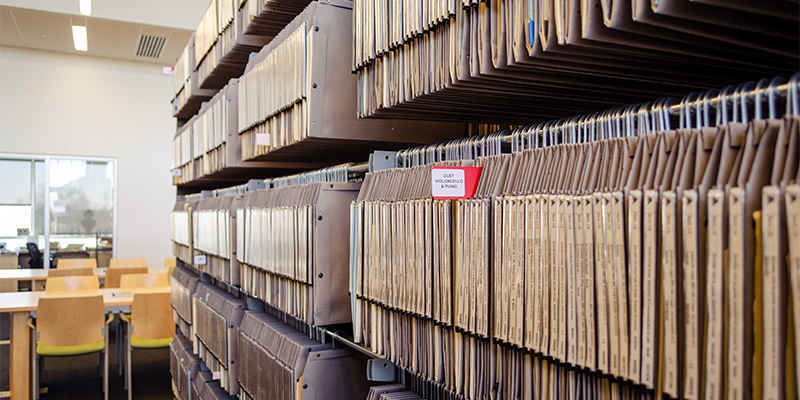It starts with a few scores. Then a few more. Before you know it, your library's carefully curated music collection is hiding under desks, overflowing into offices, and just generally stacked anywhere there's an inch of space. That's the reality for many music libraries, especially those juggling legacy media, new donations, and decades' worth of sheet music.
Unlike general collections, sheet music storage presents a few unique challenges. Scores come in all shapes and sizes; some are fragile, some are oversized. And almost all of them need to be easy to access, find, and return without creating unnecessary chaos or clutter. While the wrong storage setup wastes space, it also makes it harder for staff and students to actually use the materials.

That's the situation the UNC School of the Arts found themselves in. With more than 150,000 items in their music collection, their space was over capacity, and finding creative spaces to store their sheet music could only take them so far. They needed a solution that protected their sheet music and preserved accessibility while still giving their library room to grow.
Here's how they found it.
When Sheet Music Storage Hits a Sour Note
The old Benjamin F. Ward Music Library at UNC School of the Arts was bursting at the seams. Their collection had ballooned out to 115,000 items, including 55,000 pieces of sheet music. Their space hadn't been able to keep pace with their materials, which were scattered across the floor, shoved under desks, and packed into more than 50 mismatched file cabinets.

"Things were stacked all over the place — in offices, under tables," said Head Librarian Leslie Kamtman. "We always knew where everything was, even if it meant pointing at someone's desk or behind someone's chair. It worked...until it didn't."

Even though the staff made it work, the growing collection was putting increasing strain on access and preservation. Sheet music came in all shapes and sizes, making it hard to shelve properly. Heavy items like LPs and sound recordings needed secure, easy-access storage. And many materials were either too delicate to be handled frequently or too important to risk damage in a makeshift setup.
Creative workarounds kept the collection afloat for a while, but it wasn't a sustainable long-term strategy, especially for an art-focused university where students rely on that collection daily. The UNC School of the Arts needed a music library that supported student success while maintaining the collection and gave students and staff the opportunity to use materials as often as needed.

Without the right sheet music storage systems in place, the collection was at risk of becoming more burden than benefit.
Making Room for the Music (and Everything Else)
To house a music collection right, especially one that's constantly growing, you need a system that adapts. After all, some scores come spiral-bound and oversized, while others live in slim folders or boxed sets. And that's before you get into CDs, LPs, and a whole tech library's worth of recordings.
Luckily, that's exactly what the UNC School of the Arts got with their redesign. Think open-faced cantilever shelving for easy browsing and weirdly-shaped portfolios, or high-density mobile shelving for media that needs to stay organized but accessible. Adjustable heights, clear labeling, and smart configurations make all the difference when you're juggling 100,000+ pieces.

Inside the new 75,000-square-foot Semans Library, all of those pieces found a proper home. Sheet music storage got a major upgrade with custom cantilever shelving designed specifically for oversized scores. Meanwhile, 33-foot-long Spacesaver mobile shelving units glided along rails, giving students access to thousands of CDs, LPs, and miniature scores, and that's all without wasting an inch of floor space.
Everything had a proper home, and what used to feel like a cluttered concerto now felt like a system in sync. The updated system protected fragile pieces while keeping them accessible, no delicate scores lost in deep storage. And it didn't take a warehouse crew to move a shelf. “This is heavy material,” said Christia Thomason, head of the Music Library’s technical services. “But even the smallest staff member can move it with ease.”

"This new building is heads and shoulders above what we had," she continued. "The quality of the compact shelving is exemplary. We're very, very pleased with what went in."
Planning Your Own Sheet Music Storage System
Collections vary widely in size, format, and use, so when it comes to organizing your music library, no two sheet music storage systems should look the same. And as with everything else, planning ahead makes all the difference.
For the UNC School of the Arts, their biggest win came from thinking beyond today's immediate needs. As Leslie Kamtman put it, "Ask for more storage capacity than you think you'll need, because you never know what future gifts are right around the corner."
That kind of foresight can save years of headaches. If you're thinking about upgrading your own music library setup, here are a few things to plan for:
- Get specific with measurements, right down to the millimeter.
- Catalog your formats: Scores, recordings, folios, box sets, etc.
- Think about access: Open shelving and secure media have different requirements.
- Consider climate and other preservation needs.
- And lastly, design with future acquisitions in mind.
But above all, make sure you're working with a partner who understands libraries. "To some people, shelves are shelves, but they're not," said Thomason. Added Kamtman, "Make sure you're working with a company that understands the specific, specialized needs of your materials. What works in the general collection doesn't work for us."

The takeaway? Plan ahead. Get specific. And build a system that serves your community both now and down the road.
Check out the full UNC School of the Arts case study to see how everything came together. Or, if you're ready to compose your own sheet music storage plan, talk to a Patterson Pope rep today. Together we'll build a system that's pitch-perfect, both now and for years to come.


















